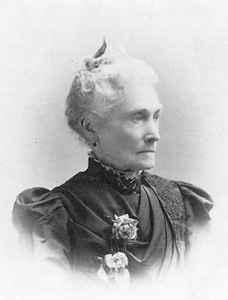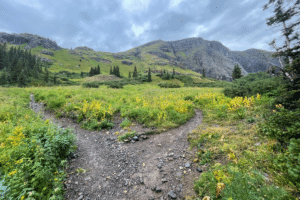Women’s suffrage is an important part of the history of Mormon women and the Relief Society. Because the majority of Mormon women in the nineteenth century were living in Utah territory, Utah history characterises Mormon Women’s suffrage. Thus, Utah history is the axis from which Mormon women’s history is cultivated, even outside of Utah, even outside of the United States.
 In the 1847 settlement of Salt Lake, women living in the Salt Lake area were allowed to vote by ballot. Though limited and not well documented, this is possibly the first time in US history where women voted in conjunction with men.(1) In 1870, Mormon women gathered to address a room of male reporters at a meeting in the old Salt Lake tabernacle. The women eloquently orated for the rights of women to practice their religion, a religion wherein, among other issues at hand, women were expected to raise their hands in vote to sustain church leaders.(2) Territorial legislature allowed Utah women the vote in 1870, but the 1873 Edmunds Act -aimed at persecuting polygamy- disenfranchised the vote from all practicing and sympathisers of polygamy, men and women alike.(3) The Edmunds Act was not as disempowering to church leadership as intended, so the more robust Edmunds-Tucker Act of 1887 was signed into law, nearly financially ruining the church, and disenfranchising all women in the Utah territory. The 1890 end of polygamy was followed by the 1891 Territorial vote wherein franchised men restored the vote to Utah women. At its inauguration as a US state in 1896, Utah was the third US suffrage state. (4)
In the 1847 settlement of Salt Lake, women living in the Salt Lake area were allowed to vote by ballot. Though limited and not well documented, this is possibly the first time in US history where women voted in conjunction with men.(1) In 1870, Mormon women gathered to address a room of male reporters at a meeting in the old Salt Lake tabernacle. The women eloquently orated for the rights of women to practice their religion, a religion wherein, among other issues at hand, women were expected to raise their hands in vote to sustain church leaders.(2) Territorial legislature allowed Utah women the vote in 1870, but the 1873 Edmunds Act -aimed at persecuting polygamy- disenfranchised the vote from all practicing and sympathisers of polygamy, men and women alike.(3) The Edmunds Act was not as disempowering to church leadership as intended, so the more robust Edmunds-Tucker Act of 1887 was signed into law, nearly financially ruining the church, and disenfranchising all women in the Utah territory. The 1890 end of polygamy was followed by the 1891 Territorial vote wherein franchised men restored the vote to Utah women. At its inauguration as a US state in 1896, Utah was the third US suffrage state. (4)
The 1870 tabernacle meeting is mentioned in Daughters in My Kingdom (DIMK), but only through the lens of the defence of polygamy. In this, it is sadly, yet wholly absent of the purpose of women’s suffrage to which the meeting was also dedicated(5). To be true, there was significant argument for Mormon women in this meeting to defend “Celestial Marriage,” which was often manifested by engaging in plural marriage. However, I think it is important to consider the property rights of women were also at stake, which brings in the invitation of a larger argument of historical application in social practice. In short, this meeting has considerable importance in the suffrage history of Mormon women, well beyond polygamy (6). Two years following this significant meeting (1872), the Mormon Women’s Exponent, a sentinel for Mormon women’s suffrage, was born.
The first international women’s day was in 1909. At first a distinctly political event aimed at a suffragist and socialist ideology, it has developed tangs of romance, appreciation, and awareness for women across the globe, to educate and bring women together. Likewise, one of the purposes of Daughters in My Kingdom is to teach the history of the Relief Society, to bring appreciation and awareness of the historical contribution of Mormon women, even if only in a romanticized style. As Julie Beck said, “We study our history because it unites faithful women. The history of Relief Society is a Spirit-filled story of strong, faithful, purposeful women.” (7)
The Exponent blog and Exponent II magazine is no stranger to addressing the contribution and concerns of women, as can be seen in any of our blog posts and magazine contributions. Indeed, we have addressed Daughters in My Kingdom in various posts, including Heather’s beautiful use of the text as a tool to teach English, an invitation to contribute to an overall lesson plan dedicated to the entire book by KellyAnn, and EmilyCC’s “Practical Applications” in both the blog and Exponent II. Suzette has suggested the book as a tool for teaching about women and sisterhood and in another blog, Ardis Parshall confessed her distraction from the text because of its high proportion of images. In these, it is clear that its uses and applications are developing within the world of Mormon women, often for good.
With this in mind, the Exponent is executing a series of lesson plans dedicated to teaching and expanding the concepts in each chapter of Daughters in My Kingdom. This series is commencing on March 8 (AU-EST, which roughly is March 7 US-EST), International Women’s Day and ends on March 17 (US-EST), the 171st Anniversary of the Relief Society.
In this marriage of International Women’s Day and the history of the Relief Society, we invite you to learn, engage and develop the history and concepts of Daughters in My Kingdom. These lesson plans are intended to assist Relief Society teachers who are specifically teaching DiMK, as well as for use as resources ascribed here, including use in Family Home Evenings, home teaching, visiting teaching and for men and women preparing to serve a mission. I also suggest that you write and record your own feelings on the book. Has it helped you feel more drawn to the women of the early church? Do you better feel you are a daughter in God’s kingdom?
Happy International Women’s Day!
- Hubert Howe Bancroft. History of Utah, 1540-1887. San Francisco: The History Company, 1889, 272.
- Derr, Cannon, Beecher, Women of Covenant, Deseret 1992, 110-113.
- Hinton, Wayne K. Utah, American Historical Press, 2000, 86-87.
- Gordon, Sarah Barringer, The Mormon Question, University of North Carolina Press, 2002.
- Tanner, Susan W., Daughters in My Kingdom, 46-47.
- Basch, Norma, “Invisible Women: The Legal Fiction of Marital Unity in Nineteenth-Century America, Feminist Studies, Summer, 1979, 346-66. Shammas, Carole “Re-Assessing the Married Women’s Property Acts,” Journal of Women’s History, Spring, 1994, 9-30. Salmon, Marylynn, Women and the Law of Property in Early America, Chapel Hill & London, University of North Carolina Press, 1986.
- Beck, Julie, Daughters in My Kingdom
Note: The image used is of Sarah Granger Kimball. Kimball was the one who suggested that the women gather in her home to sew shirts for the men who were constructing the temples. After this meeting, the first Relief Society was organized. In her life, amongst other things, she served as General Secretary of the Relief Society under Eliza R. Snow, and was president of the Utah Women’s Sufferage Association. Her natural idological blending of dedication to Relief Society and women’s sufferage has made her into one of my favourite role models.






3 Responses
[…] By Spunky […]
I LOVE this idea, Spunky! I worry these manuals are gathering dust on too many shelves.
Are all of the links going to be published into one post that can be used a resource?